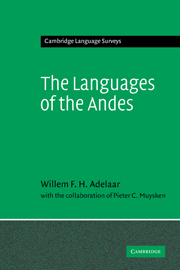Book contents
- Frontmatter
- Contents
- List of tables
- List of maps
- Preface
- Orthographic conventions
- List of abbreviations
- 1 Introduction
- 2 The Chibcha Sphere
- 3 The Inca Sphere
- 4 The languages of the eastern slopes
- 5 The Araucanian Sphere
- 6 The languages of Tierra del Fuego
- 7 The Spanish presence
- Appendix: Inventory of languages and language families of the Andean region
- References
- Author index
- Index of languages and ethnic groups
- Subject index
2 - The Chibcha Sphere
Published online by Cambridge University Press: 22 September 2009
- Frontmatter
- Contents
- List of tables
- List of maps
- Preface
- Orthographic conventions
- List of abbreviations
- 1 Introduction
- 2 The Chibcha Sphere
- 3 The Inca Sphere
- 4 The languages of the eastern slopes
- 5 The Araucanian Sphere
- 6 The languages of Tierra del Fuego
- 7 The Spanish presence
- Appendix: Inventory of languages and language families of the Andean region
- References
- Author index
- Index of languages and ethnic groups
- Subject index
Summary
The present chapter deals with the languages of the northern Andes; the term ‘Chibcha Sphere’ has been chosen because of the historically important role of the Chibcha people in that area. In the Sixteenth century the Chibcha or Muisca were the inhabitants of the highland region that coincides with the modern Colombian departments of Boyacá and Cundinamarca. Although historical sources insist that there was no linguistic unity, it is likely that most Chibcha spoke closely related languages or dialects belonging to a subgroup of the Chibchan language family. At least two languages have been identified: Muisca was spoken on the upland plain (sabana) surrounding the present-day Colombian capital Santafé de Bogotá (department of Cundinamarca) and Duit in the department of Boyacá. By their location in the highlands east of the Magdalena river valley, close to the Amazonian plains, the Chibcha held a peripheral position in the Colombian Andes. Therefore, their linguistic influence on other parts of that area must not be overestimated.
The Chibcha were a populous agricultural nation, who specialised in the cultivation of potatoes and cotton. They were divided into several chiefdoms, two of which occupied a leading position. A southern chiefdom, centred in Bacatá or Muequetá (near the modern town of Funza, close to present-day Bogotá), was ruled by a king called the zipa.
- Type
- Chapter
- Information
- The Languages of the Andes , pp. 46 - 164Publisher: Cambridge University PressPrint publication year: 2004

